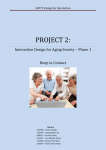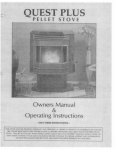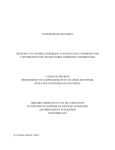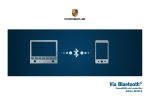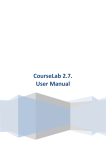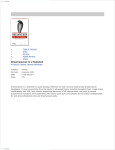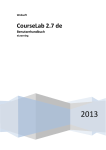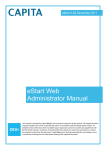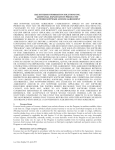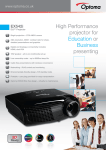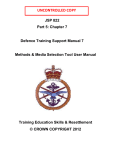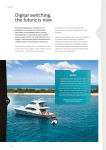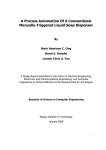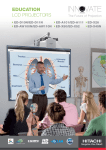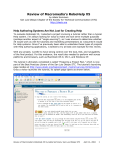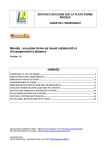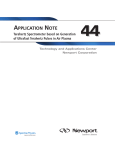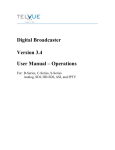Download Defence training support manual 5
Transcript
JSP 822
Part 5: Chapter 5
Defence Training Support Manual 5
Learning Technologies Handbook
Defence Centre of Training Support
© CROWN COPYRIGHT 2012
Defence
CONTENTS (click on links to view)
Page
Introduction
ii
Identifying the Requirement for LT
1
Integrating LT into the Workplace
3
Advantages of LT to the Organisation
5
Minimising LT Weaknesses
7
Top 10 Tips to keep your Learners Engaged
9
Rapid Authoring Tools
10
Design and Engagement
14
Interface Design
20
Learning Technologies Checklist
27
The Defence Learning Portal (DLP)
30
Procurement of LT Checklist
33
6 Levels of a Learner
34
List of Media
36
Glossary of Terms
79
Learning
Technologies
Handbook
DTSM5
Version
1.2
Page i
Introduction
Learning technologies is the broad scope of technologies (including hardware, software and
communication networks) that can be used to support, manage and deliver learning.
(Defence Manual of Training & Education Glossary JSP 822 Part2).
The Learning Technologies (LT) Handbook has
been produced to support current LT policy. Its
aim is to provide guidance for anyone involved
in developing or implementing LT within
Defence. Readers are therefore strongly
advised to be aware of the policy within JSP
822 Part 3 Chapter 5 (Learning Technologies)
before using this document. In addition, it is
advisable to read the Defence Training and
Education Optimisation Strategy and the
Methods and Media Selection Tool User
Manual. Links to all documents referenced are
available on the DCTS Learning Technologies
Website (search: DCTS LT on the Defence Intranet).
Each section of this handbook includes practical advice on how effective and efficient LT can
be created and implemented. Defence has been using LT for many years and examples of
good practice have often been prevalent, however with the large increase in the number of
new technologies available, there are now significant variations in both their development and
deployment across Defence. In order to bring more coherence to the way LT is applied, this
handbook has been written, in consultation with practitioners across Defence, to provide
guidance which supports future LT developments and implementations.
The authors (LT Research and Development (R&D) Team) are part of the
Learning Technologies Group within DCTS and have been in existence
since 2007. At inception, LT R&D was tasked to widen their scope away
from just producing simulation programs for legacy aircraft and more
towards focussing on becoming the
Centre for Excellence for all
Defence LT. Since then, the team has trialled a large
number of different applications that could be used to
develop or manage LT content. One such project was
the investigation of a variety of rapid authoring tools
which were currently available on the open market
(ranging from freeware to high-end authoring tools).
Extensive research was undertaken in order to provide
back pocket briefs on each tool. This information was
Defence
Learning
Technologies
Handbook
DTSM5
Version
1.2
Page ii
then made available to the rest of Defence and was used to justify the business case for an
enterprise licence procurement (currently the web-based tool CourseBuilder by Lumesse).
With the addition of extra personnel to the team, R&D were also able to move rapidly into the
serious games arena utilising OpenSim to create a virtual DCTS on the local network (a flash
based virtual DCTS serious game was also developed for the DLP along with a Chemical,
Biological, Radiological and Nuclear (CBRN) game . In terms of social or peer-to-peer
learning, R&D LT trialled the first moodle on the DLP, as a community of practice, which was
then implemented by the RAF( PMD Air) and more recently the Defence and Army VLEs. The
LT R&D team hope that by trailblazing such implementation issues other units will be able to
optimise their T&E with greater ease.
For further information and contact details search DCTS LT on the Defence Intranet or the
Internet (www).
Defence
Learning
Technologies
Handbook
DTSM5
Version
1.2
Page iii
Identifying the Requirement for LT
Other Defence documents, principally JSP 822, describe policy and guidance for the whole DSAT
framework including the identification of T&E requirements. Various types of LT media can be
considered as possible solutions to T&E requirements ranging from innovative new T&E proposals to
an incremental improvement to current methods. These considerations could occur at various stages
of the process, however most influence is likely to occur during the Training Resource Estimate or
Training Options Analysis phase of DSAT.
For all LT requirements across Defence, an analysis of the
most suitable methods and media is to be undertaken and
documented before procurement is recommended. Not all LT
are suitable for all training and education requirements. In
order to select the most appropriate media (such as LT), an
analysis of suitable methods is required first. The
recommended Methods and Media Selection Tool (MMST)1 is
a simple application which includes e-learning and reference
material for this purpose and supports the Defence Training
and Education Optimisation Strategy2. The MMST provides a
simple and fast framework for
ensuring that a basic level of
analysis is completed before
the development or
procurement of new LT. The tool is flexible in that it can incorporate,
with minimal delay, new underpinning criteria once consensus across
Defence is reached. The MMST is best used as a support tool as part
of a working group discussion. Ideally this group should include subject
matter experts, training/education specialists, course designers and
sponsors.
After the methods and media selection analysis has identified possible
LT, further guidance may be required. Before planning development
and implementation of LT, contact is to be made with single Service (sS) Learning Technology
Working Group representatives3 for advice or, for those Defence units without a sS lead, Learning
Technologies at DCTS. To avoid duplication of effort and wasting resources, contact with single
Service leads, will allow an oversight of current capabilities. The Learning Technologies Working
Group is a forum through which sS leads can then share and capture knowledge across Defence.
1
MMST details are in the MMST User Manual JSP 822 DTSM 7
The Defence Training and Education Optimisation Strategy is published as a DIN with a link on the DCTS LT website
3
Single Service Learning Technology Representatives are: D Trg SO2 LT Pol or SO2 LT DD (Army), TBTU OC (RN),
HQ 22 Gp SO2 LT (RAF), DLPO Def Ac (Civil Service).
2
Defence
Learning
Technologies
Handbook
DTSM5
Versi on
1.2
Page 1
Back to Contents
Units embarking on LT implementation projects should aim to engage with other units across
Defence who are using similar LT. DCTS Learning Technologies coordinates a spreadsheet of
ongoing LT projects across Defence, including contact details, which is available on the DCTS LT
website. Units, through their sS reps, should aim to keep DCTS. LT informed on a regular basis so
that this resource can be kept up to date.
Defence
Learning
Technologies
Handbook
DTSM5
Versi on
1.2
Page 2
Back to Contents
Integrating LT into the Workplace
Integrating learning into the workplace has had many issues over the years; in particular with finding
the time to allow staff to go onto training courses. For industry this has been a particular bone of
contention because time away from work means a loss in production and this is ultimately at great
cost to the company. Although in the military we are not driven by profits, having our staff away for
days or even weeks at a time can have a knock on effect to our personnel and managers alike. For
the managers, they have to ensure there is sufficient manpower in place to cover the loss of their
staff whilst they are away training. For our personnel, time at home in the present global climate is
precious, having been away from home due to numerous Out of Area commitments. Nobody likes
being away from home for too long and if it is for training, personnel would much prefer to do it at
their unit. Another major factor in wanting to integrate LT into your training is that if the new skills
learnt are not put into practice straight way then there is significant skill fade. In 1885, Ebbinghaus
published his groundbreaking Über das Gedächtnis ("On Memory", later translated to English as
Memory. A Contribution to Experimental Psychology) in which he described experiments he
conducted on himself to describe the processes of learning and forgetting.
Ebbinghaus made several findings that are still relevant and supported to this day. Firstly, his
arguably most famous finding – is the forgetting curve (see below). The forgetting curve describes the
exponential curve that illustrates how fast we tend to forget the information we have learned. The
sharpest decline is in the first twenty minutes, then in the first hour, and then the curve evens off after
about one day.
To combat this skill fade in the past we would send our personnel on another training course.
However, LT allows users to utilise the learning package as pre-course training, initial training or
refresher training. Refresher training is particularly useful when the individual cannot remember a
certain procedure to follow and needs to refresh their memory of the correct procedures again.
Ebbinghaus Curve - Amount of information retained following a lesson.
The traditional model of learning (see below) shows there is a great deal of disruption to the learner
in terms of going away for training. Compare this with the New Model of Learning (underneath)
Defence
Learning
Technologies
Handbook
DTSM5
Versi on
1.2
Page 3
Back to Contents
whereby if LT is incorporated into the learning cycle, time and disruption to the workforce is greatly
reduced. It has been proven that LT aids retention of information through continuous reinforcement
and allows the learner to learn new skills.
Traditional Model – Weak Alignment of Work and Learning
Learning (including
LT) is incorporated in
the work place
Defence
Learning
Technologies
Handbook
DTSM5
Versi on
1.2
Page 4
Back to Contents
Advantages of LT to the Organisation
There are many advantages for the organisation, instructor and learner when LT is incorporated into
the learning cycle and these can include the following4:
Reduced overall cost is the single most influential factor in adopting LT. The elimination of
costs associated with instructor's salaries, meeting room rentals, and student travel, lodging,
and meals are directly quantifiable. The reduction of time spent away from the job by
employees may be the most positive offshoot.
Learning times reduced, an average of 40 to 60 percent, as found by Brandon Hall5 .
Increased retention and application to the job averages an increase of 25 percent over
traditional methods, according to an independent study by J.D. Fletcher6.
Consistent delivery of content is possible with asynchronous, self-paced LT.
Expert knowledge is communicated, but more importantly captured, with good LT and
knowledge management systems.
Proof of completion and certification, essential elements of training initiatives, can be
automated.
Increased availability of training. Modern LT allows access from a variety of sources such
as home PCs and mobile phones.
Learners proceed at their own pace.
Opportunity for personalised learning rather than one size fits all.
Increased level of one-to-one interactions.
Instant task-orientated and personalised feedback. Learners can also respond to the
feedback through social learning LT such as forums and blogs.
Fewer training resources.
Advantages to the Instructor
Student profiling – specific weaknesses can be automatically targeted with remedial work.
Increased participation – (if properly designed).
Immediate, individualised feedback.
4
Disadvantages of LT and possible solutions are covered in the next section
Web-based Training Cookbook, 1997, p. 108
6
Multimedia Review, Spring 1991, pp.33-42
5
Defence
Learning
Technologies
Handbook
DTSM5
Versi on
1.2
Page 5
Back to Contents
Student motivation.
Assessment and monitoring
Training consistency
More time for instruction
Safe training environment
Advantages to the Learner
Defence
On-demand availability enables students to complete training conveniently at off-hours or
from home.
Self-pacing for slow or quick learners reduces stress and increases satisfaction.
Interactivity engages users, pushing them rather than pulling them through training.
Confidence that refresher or quick reference materials are available reduces burden of
responsibility of mastery.
Learning
Technologies
Handbook
DTSM5
Versi on
1.2
Page 6
Back to Contents
Minimising LT Weaknesses
As with any training program there are always weaknesses. However, if we realize the weaknesses
of LT from the outset and do as much as we can to mitigate them, then the LT project will have a
better chance of succeeding. To aid you in your design and implementation of LT, a table has been
produced to assist you in overcoming some of the issues you may face.
Issue
Possible Mitigation
Sell benefits/marketing
Break into short modules 4/5mins
Motivation of learners
Support of some kind (e-tutoring)
Simple, effective design
Support
Taster sessions
IT Skills of audience
Analyze situation
Understand target level, pre-assess (ECDL)
Clear instructions, easy to use
Command chain “buy-in”
Schedule learning times
Minimising interruptions
Allocate rooms/suite
Make managers aware
Test before delivering to user
Technical support required
Identify a minimum spec
Defence
Learning
Technologies
Handbook
DTSM5
Versi on
1.2
Page 7
Back to Contents
Issue
Possible Mitigation
Liaise with SPOC/DLP
User friendly systems (KISS)
Management support
Cultural change in your organisation
Corporate and employee responsibility
Marketing/comms plan
Tutor access
Isolation of learners
E-Tutoring
Line manager/trainer support
Look at “blend”
Doesn’t suit all learners
Design – balance interactivity and further
reading/research
Security passwords
Cheating
Observer/checker
Show alternatives
Perceived cost
Sell benefits through a consistent message
Defence
Learning
Technologies
Handbook
DTSM5
Versi on
1.2
Page 8
Back to Contents
Top 10 Tips to keep your Learners Engaged
A varied approach will keep your learners focused and enthused to want more. This approach
may include points from the following list:
1.
Content is relevant and pitched at the appropriate level, ideally work related and
written with the audience in mind. Communicate the benefits.
2.
A theme or a story to follow, that includes the opportunity to have the learners
interacting with the introduction of questions and activities.
3.
Clear objectives that are supported by the content and a logical structure using the
stages of the learning process as a guide.
4.
Layout that is clear and uses the space well, with considerations for access and
functionality.
5.
Interactive – is not too text driven.
Information is broken up into short sharp
chunks of information with a variety of
questions and activity pages.
6.
Interesting and engaging visual
media that is relevant and appropriate e.g.
not using animation/video for the sake of it.
7.
Good structured layout and
content with clear instructions on what to
expect and how to navigate around the
site.
8.
Learner focused and learner is in
control of content (e.g. turn off sound /
replay a video clip) and easy to navigate.
9.
Ability to review (quiz / test) and easily re-visit topic area. Also provide links to further
learning / reading.
10.
Defence
Learning
Add the human element for support / motivation.
Technologies
Handbook
DTSM5
Versi on
1.2
Page 9
Back to Contents
Rapid Authoring Tools
Authoring tools have liberated course developers from their dependence on programmers.
Furthermore they enable us to produce and distribute lots of LT quickly, however, quality and
effective learning must be maintained – the LT is only as good as its instructional design.
There is a growing problem in the LT industry. Tools are increasingly being used to enable users with
little or no instructional design experience to create large amounts of LT. (Reuben Tozman).
What is an Authoring Tool?
“A software application that allows individuals to create their own LT content, without needing to have
programming skills.” (Brandon Hall Research)
The Levels of Authoring Tools
Basic authoring tools can be classed as follows:
Template tools requiring little or no training.
Highly formatted with a course development process that’s driven by a sequence of dialog
boxes
Limited flexibility
For when ease of use is more important than creativity
Mid-range authoring tools can be classed as follows:
More training for extended creative latitude
Used to create many of today’s LT
High end authoring tools can be classed as follows:
High-end multimedia simulations with sophisticated graphics and audio
Defence
Learning
Technologies
Handbook
DTSM5
Versi on
1.2
Page 10
Back to Contents
May need some time to learn
Lots of creative freedom
Courses created with these rival computer games - intricate and complex sound and
animation sequences
Ultimately you should try and find an optimum balance between ease-of-use features and creative
freedom.
There are literally hundreds of authoring tools available on the open market. Some of these are free
to download from the web (e.g. CourseLab) but they are not accredited for MOD systems. The
current web-based tool available for Defence7 is CourseBuilder by Lumesse. with licences available
from DCTS LT R&D at no cost to individual units. Moreover, DCTS offer training and support with
more details available on the DCTS website.
Content Creation Service
The Content Creation Service (CCS) on the DLP is a web-based application for the development of
e-learning. The following paragraphs explain the CCS in more detail:
Benefits
For conciseness the benefits scope has been limited to those accrued by using a web-based
collaborative rapid authoring tool for the in-house development of e-learning8 . The following benefits
were recognised during the evaluation phases of the project:
•
Compared to bespoke e-learning produced by commercial development companies
the cost of production was about 90% less – this includes the capitation rates of the in-house
SME developers.
•
Development time (flash to bang) was
reduced by around 50% by using in-house SMEs.
Communication overheads between commercial
developers and SMEs were significant due to the
specialised nature of most military content. With
SMEs doing the development themselves this
overhead is eliminated. Collaborative access to
content under development also allowed easy
peer review rather than the time consuming
process of packaging and sending content for
review via email (or even CD due to the often
large file sizes).
7
8
Defence
Fully accredited on the DLP Content Creation Service
These benefits are more specific than the wider LT benefits highlighted elsewhere in this publication.
Learning
Technologies
Handbook
DTSM5
Versi on
1.2
Page 11
Back to Contents
•
Content is shared reducing development time even further (this improves as the
content and media library increases in size)
•
Project management elements such as work flows, quality, configuration management
and version control are streamlined and simplified.
•
Content is fast and easy to update.
Drawbacks
•
License fees for web-based collaborative rapid authoring tools tend to be expensive
compared to single-seat clientside9 apps..
•
SMEs need to be released from other duties for content creation (although creation
time is not necessarily much more than creating PowerPoint and notes/handout equivalents which SMEs already do).
•
In-house developers need to be trained and supported. Although learning the tool
itself is easy (one day), learning the skills required to be a competent e-learning instructional
designer can take much longer. Most of the 40 hour blended course delivered by DCTS to all
authors is focussed on instructional design rather than how to use CourseBuilder.
•
Initially only basic e-learning can be produced in-house however as expertise has
matured the levels of innovation and creativity have increased (this is enabled by the sharing
of content). Bespoke developers are also used for higher level development such as Flash
interactions, 3D models/environments, complex branching scenarios and emulations however
these should interoperate with CourseBuilder so that content can be shared and updated.
Benchmarking
DCTS LT R&D attended several seminars and conferences and benchmarked with other
organisations who use web-based rapid authoring tools such as CourseBuilder. The most significant
difference was concerning who actually created the
content. Most organisations created an in-house
development team and purchased a limited number
of licenses just for this team’s use (these
organisations included companies such Tesco,
Lloyds and the National Farmers Union). As
described previously, it is advised that the SMEs
themselves should create the e-learning so as to
avoid the communication overheads of specialised
content. Therefore, DCTS purchased an MOD
enterprise license, through the DLP contract, so
that all SMEs can develop, rather than just in-house
teams. This is similar to the current situation where
9
Defence
Clientside applications are loaded on the user access device (Desktop, Laptop, Mobile Phone etc)
Learning
Technologies
Handbook
DTSM5
Versi on
1.2
Page 12
Back to Contents
SMEs build their own PowerPoint (yet CourseBuilder is just as easy to learn).
Barriers
MOD regulations were that content would need to be created in a secure environment. This required
significant extra costs and time for implementation as, unlike most other organisations, Defence were
unable to use the companies’ own servers.
SMEs motivation and ability towards e-learning development varied significantly. Many required
constant encouragement.
Lessons Learned
Implementation to enterprise status took 3
years which in hindsight was longer than
anticipated. One year delay was due to
trying to manage the hosting, accreditation
and commercial requirements process
internally. This proved far too complex and
time consuming for the DCTS LT team and
consequently the decision was taken to use a
commercially managed service at slightly
greater cost.
Due to lack of resources, minimal effort was expended on marketing and PR within the MOD. This
resulted in a slow take up of CourseBuilder and some units were still purchasing other tools during
the implementation.
Defence
Learning
Technologies
Handbook
DTSM5
Versi on
1.2
Page 13
Back to Contents
Design and Engagement
In this section we will be looking at the elements of effective LT design and how we identify engaging
materials. Too many times in the past and unfortunately even now, personnel involved in designing
LT think that they can just import PowerPoint presentations and convert them into LT. Although there
are tools out there that can do this, it is not really something that should be used as the norm and
time well spent in the design phase will pay huge dividends at the end. As the statement goes
‘rubbish in, rubbish out?’
Firstly, when you are thinking about your project in
the design phase you should consider the 4As of LT
design as described by Neil Lasher. Lasher states
that you should consider the following:
Attraction
Attention
Availability
Application
We will now look into a little more detail on these four
concepts.
ATTRACTION – There are 3 things you need to
consider when looking at attraction:
Why this and not an alternative?
Easy to use?
Quick to finish?
How do TV programmes keep you hanging?
You have 0.1 seconds to attract a potential learner when a page opens. What can you do to
ensure that the learner wants to continue using your LT package?
What draws the user in, engages them and leaves them satisfied? Remember, Attraction will
ensure the user wants to use this intervention instead of another.
Easy to use?
The Module should be intuitive
Do they need instructions or is it all self explanatory to use?
Defence
Learning
Technologies
Handbook
DTSM5
Versi on
1.2
Page 14
Back to Contents
Does the LT follow a Logical flow? Are there “traps”?
Quick to finish?
Users gain best knowledge transfer and longer term retention from shorter task related
modules. Start to overlap with “Attention” mentioned below.
E.g. Three 5min modules each with a single point will be more
effective than one of 15 min modules that cover 3 similar points
In the end, remember to ask yourself the following – “So,
what is the attraction for the end user?”
Knowing how long it is
Amusement
Grabbing interest
Introducing and maintaining a “want”
ATTENTION – to maintain the attention of the user we should consider the following 3 points in order
for us to ensure we maintain the attention of the student. These are as follows:
To the point
Consider the needs of the user
Direct information – with links to the theory
To the point – in this area you should ensure that the following are considered:
Modules narrowly focussed to a single learning point (no noise – 7 chunks of info at a time)
Consideration to understanding rather than just simple knowledge transfer
Considering the needs of the user
It should be exactly what the user needs and no more
Avoid frustration and courses being left incomplete
Direct information – with links to the theory
Offer direct information then link to the theory elsewhere, hyperlinks etc.
Keep attention to the point
Defence
Learning
Technologies
Handbook
DTSM5
Versi on
1.2
Page 15
Back to Contents
Provide user with links to further information (which is clearly marked as the theory behind the
learning) text books, websites, case studies etc.
AVAILABILTY – look at the 3 points listed below:
Learn, use, forget
Up-to-date
Always re-findable
Learn, use, forget
The Internet changed the way we work (back to back meetings, high volumes of data, ease of
access, less time to think).
Information changes rapidly, what’s relevant today may not be tomorrow – just in time and
workflow models satisfy these issues (people go to the internet to access information required
immediately and they tend to use and then forget).
Focus on short term memory rather than long term memory; therefore, focus to deliver
information in a way that can be easily and instantaneously transferred by the user to fulfil the
need of the current task.
On completion student can forget info as it likely it will have changed next time they need to
use it.
As Einstein stated “it’s not what you know, it’s where to find it”.
Up-to-date
Versions should be easily identified outside of the learning (e.g. on an LMS) as change of
significant data in the module may be the reason the user is returning not because he wants
to relearn the process.
Credibility of your course (links back to maintaining attention).
Important to acquire source code if dealing with contractors.
Always re-findable
Not just the module in the system (or course in the LMS) but also the data in the module.
When the user returns what will they need? More flexibility in what order they can access info
– not stuck to the rigid structure a first time user might be forced through.
Every course requires change history page so returning users can see how it was before.
Defence
Learning
Technologies
Handbook
DTSM5
Versi on
1.2
Page 16
Back to Contents
APPLICATION
What’s in it for me?
Relate learning to the “job”
Use simulations to practice and test application
This should have no complications
What’s in it for me?
Single most important area is motivation to apply.
Different options for different user circumstances e.g. seniority, experience, and
organisational context
Excite the user during the intervention so they will want to use what the module contains
Each module should suggest to the user that they go and use the info they have gained or
process they have learned NOW
Relate learning to the job
Provide assessment at the right time and as a separate intervention when the user has had
time to reflect, explore the theory or actually use what they have learned in a task they are
working on
Assist learner by providing checklists or job aids that they can take away and follow to
complete a task
Simulations
How will you implement these design ideas?
How do they compare with what you’re already doing?
ANATOMY OF AN LT TUTORIAL
As well as following the four steps as described by Neil Lasher, it is important to look at the points
raised below. At the end of the day, if we do not engage our learners and they do not see any
relevance as to why they are doing this training, then no matter how good the LT package is, it is
ultimately doomed to failure. In this section we will look at 3 areas of LT design.
Ingredients
Defence
Learning
Information
Practice
Review
Technologies
Handbook
DTSM5
Versi on
1.2
Page 17
Back to Contents
Engagement
Relevance of material
Meaningful interactivity
Rich media
Relevance
Through examples
Through inductive questioning.
We will now look at these areas in greater detail.
Ingredients
Information: learning material needs to be presented in various ways – text descriptions,
diagrams, still images, rich media, interactive graphical media (e.g. 3D models, diagrams with
pop up explanations). Make sure you choose the correct media for your students?
Practice: learner needs to experiment with the learning material (NB application) to ensure
they fully understand the concepts. This can be done by utilizing the following: test questions,
case studies, simulations, games, tasks to perform on-line.
Review: tutorial must provide guidance in response to the students’ practical work, e.g.
automated feedback or checklist with which the learner can check their own work.
Engagement
Relevance of material: if material isn’t relevant to the learner’s goals then you’re wasting
your time and effort.
Meaningful interactivity: concentration of meaningful interactivity is one of the reasons why
self-study materials can be so efficient in reducing learning times as these challenges the
learner and heightens their attention levels, thus makes it difficult for learner to get into
passive watching and listening mode.
Rich media: sound and motion will attract attention but whether it holds it without the aid of
relevant material and interactivity has little supporting evidence. Best use is when the
learning content demands it (e.g. to explain things that cannot be adequately conveyed using
text and graphics).
Relevance
Examples: to clarify concepts, transform abstract info to material that is relevant and
applicable.
Defence
Learning
Technologies
Handbook
DTSM5
Versi on
1.2
Page 18
Back to Contents
Inductive questioning: using questions to build on learner’s experience and lead them
towards the learning point… keeps away from “lecture” appearance.
WHAT IS ENGAGING?
So what is engaging? Take time to consider why film and TV can be engaging, how good
instructors can make even the most boring lesson interesting and why you click onto certain websites
and stay on them to read the information contained within those pages. Then think about those LT
programmes that you have enjoyed and consider what made it enjoyable? How did they grab your
attention? Did they use audio, rich media etc? Write down what grabbed and maintained your
attention throughout and use them as guides of how you can engage your learners. Another good
exercise would be to write down why on the four topics above you have turned a film or TV program
off, not enjoyed a lesson or clicked straight off a web site upon opening it and any LT that you have
completed in the past which you have disliked. Use these thoughts to ensure you do not fall into the
same traps.
To assist you in deciding what engaging activities you may want to include in your LT, a small list is
shown below:
Defence
Learning
Technologies
Handbook
DTSM5
Versi on
1.2
Page 19
Back to Contents
Interface Design
In this subject we will take you through some of the basic rules that should be followed to ensure that
the look and feel of your LT does not become overtly busy and distracting to the user. If we
remember back to when training schools changed from OHPs to PowerPoint presentations,
designers and instructors alike had a multitude of actions and sounds going on when a slide was
viewed and this distracted everyone. I’m sure you all remember how many different ways text would
come onto the screen (typewriter, flying from the left/right/up or down etc) but could you actually
remember much about the subject? Unfortunately, the same thing has been happening when
individuals have designed LT. Rapid authoring tools are becoming more and more powerful tools
with greater scope for exporting your learning over a multitude of media channels to a potentially
limitless audience. Getting the interface design wrong means you could quickly lose your learners.
Over the next few pages we will explore the basic rules to interface design and just remember, if you
just tweak your layout, colour scheme, text, graphics and audio (if utilised) you could have increased
the likelihood of someone reading and remembering your well thought out content!
Layout
The Gutenberg diagram below sets out to explain how the eye travels when reading text. In the
West, people’s brains are programmed to read from left to right and from top to bottom. Edmund
Arnold states that a moving object on a screen will always become a master anchor point for the eye
and if the moving object is at the bottom of the page then it becomes difficult for the reader to move
their eyes back up to the top of the page. Therefore best practice is to not have any moving objects
on the screen once your text is being displayed. Remember, a video or Flash File may look good
and display your creativity utilizing these mediums, but to the student it is just another annoying
distraction.
The Primary Optical Area (POA) is where the eye starts scanning from. You want that to be where
the start of your info is as the eye doesn’t go back after starting at the POA. Moving objects or
Defence
Learning
Technologies
Handbook
DTSM5
Versi on
1.2
Page 20
Back to Contents
engaging images often become the Master Anchor and override the POA, therefore be aware when
animation/pictures are introduced, played and finished.
Devices which lead a reader on a wild goose chase, disturb an efficient pattern or cause the slightest
measure of distress, should be eliminated (Edmund Arnold). Arnold also insists on design which
pays tribute to the linearity of the Latin alphabet and the physiology of the act of reading. Arnold
states that any design which forces the reader to work against reading gravity, or fails to return them
to a logical axis of orientation, tends to destroy the reading rhythm and should therefore be outlawed.
Text Layout
Justification: is the way text is aligned on a page. Advertisers have in the past got this very wrong in
newspapers and magazines and unfortunately as we have seen in the past, LT is no different. The
figure below explains the reasons for using text justifications.
Defence
Learning
Technologies
Handbook
DTSM5
Versi on
1.2
Page 21
Back to Contents
Colour Schemes
When considering colour schemes during the design phase you might find that you are dictated by
your organisation of the actual skin and background to be colour used; however, great care and
attention should be placed on this element of your design as you will need to consider the needs of
those personnel who have specific learning difficulties. Eye strain and clarity of the words can all be
affected by the choice of colour scheme. Before publishing the course, get other personnel to look at
the screen to see if they have any difficulties reading the text on the page. Some Organisations have
been known to allow the end user the ability to change the screen background colours for
themselves. This is easy to do and something you may wish to consider. Below is an example of
different ways in which to present text onto light and dark backgrounds. 9 out of 10 people will prefer
a dark background and lighter text as the words are clearer and easier on the eye to read.
Another consideration is whether or not to have a gradient shaded background as seen in the figure
below. This type of background can look attractive and the dark top leading to a lighter base is
known to help draw the eye down the page. However, be careful of text clarity in particular further
down the page.
Defence
Learning
Technologies
Handbook
DTSM5
Versi on
1.2
Page 22
Back to Contents
Text and Colour
Approximately 8% of males are colour blind whereby red and green is the most common form of
colour blindness. You will find that similar colours can contrast quite well, but be aware that
background patterns can make life a struggle to read the text see below. A safe bet is either yellow
on blue or pastel coloured background with black text. Although gradients can aid drawing the eye
down the page, be wary of the style you are using and not to introduce a Moiré Effect10 whereby the
image will blur and reduce overall clarity as seen below.
Colour – Things to remember:
•
Don’t use too many different colours, particularly for text. You should try to aim for no more
than 4 colours.
•
Once set of colours have been chosen stay consistent throughout.
•
Colours have association, Red = Stop, Green = Go etc see below
•
Remember, wrong colour = wrong message and associations can build up in a program e.g.
one colour text for correct feedback and another for incorrect.
10
Visit http://www.mathematik.com/Moire for a visual demo.
Defence
Learning
Technologies
Handbook
DTSM5
Versi on
1.2
Page 23
Back to Contents
House Style
A house style can be the easiest way to remain consistent throughout. By setting up your house
style at the inception of the design phase you can ensure that you have the correct colour scheme,
logo, text style and layout set for the rest of the presentation. More information on MOD style guides
is available from Defence Media and Communications on the MOD website.
Font Type and Size. Now you have your house style squared away, it is important that you choose
the correct font type and size. Again it is imperative that you remain consistent throughout. Below
are the results of a survey11 which asked which are the best fonts for screen reading (as opposed to
print). The most popular was Verdana followed by Arial , both of which
are sans serif (without the small extensions to the letters which often are
blurred by screen pixels).
In terms of font size, when using text for describing events (not
headings) it is best to use a minimum of 12pt font with 14pt spacing as
this is what the brain is use to reading.
Should I use Double Spacing?
In terms of using double spacing, the brain finds this confusing,
remember, in LT only 4 sentences can be read before the eye becomes
tired.
Text Emphasis
To emphasise your text there are various ways in achieving this. You may decide to enlarge the text
you deem important or embolden, underline, add shadow, a different colour, use UPPER CASE or
use animation to grab the attention of the user.
11
Defence
http://www.twiigs.com/poll/Technology/Internet/12586
Learning
Technologies
Handbook
DTSM5
Versi on
1.2
Page 24
Back to Contents
In the main, underlining, use of capitals and animation should be avoided. Bold or adding colours are
the best methods to emphasise words; although, care should be taken when using colour as words
coloured on the internet have association with a link to further information.
Integrating Text and Graphics
The use of text with graphics is a very good way of reinforcing the information you are trying to impart
onto your students. By putting text either close to the graphic or better still as part of the graphic it is
referring to (see figure below), ensures that the student does not just look at the picture. Please
remember the picture will become the master anchor point (refer to the previous Gutenberg diagram)
and any text placed above will have the chance of not being read.
Integrating Audio
Should audio be used in your LT? This is a question commonly asked and one where due care and
attention should be given. As a rule of thumb, if the audio does not enhance the training then do not
use it! However, if it is deemed important, then you need to consider if you should have just narration
or narration with on screen text. It is worth considering that words presented by audio are better than
on-screen text especially when they are describing an on-screen graphic. This is because essentially
you are spreading the input over 2 channels rather than competing for the use of just one. However,
some people do not like reading the text whilst listening to the audio, or, do not like having a voice
over whilst reading the text. Therefore the ability to turn off text and or audio should always be made
available. Probably the best way to use audio and text is to introduce key bullets of text at the
appropriate points in the audio narrative. This will help to reinforce the learning points without
overloading the learner. One final thing to consider is the use of voice. Computer generated voices
are generally a no-go and you should always consider the use of a human voice. However, the
quality of text to voice applications are improving all the time and could meet the requirement in the
near future.
Defence
Learning
Technologies
Handbook
DTSM5
Versi on
1.2
Page 25
Back to Contents
Simple Tips for Designing LT.
Below are some simple tips when you are looking at designing your LT. This list is not
comprehensive and should only be used as guide.
Defence
•
Keep it simple – text, sound, motion, colour, etc. should be used to support the instruction. If it
doesn’t support it – remove it. Resist the urge to show off your cool new skills.
•
Provide a harmonious and consistent variety of text, sound, motion, colour, etc. to keep
attention and avoid learner distraction.
•
If using simulations or problem-solving interactions, replicate the real work environment as
much as possible.
•
Graphics/pictures should support the instruction and reinforce a message, not just provide
superfluous filler.
•
Limit the amount of text on a page. See http://www.useit.com for some usability guidelines.
Learning
Technologies
Handbook
DTSM5
Versi on
1.2
Page 26
Back to Contents
Learning Technologies Checklist
The following 12 Key Themes provide a checklist and focus for project teams when developing a
Business Case for LT. The themes are based on our current issues and will enable a coordinated
approach to achieving successful outcomes. Further detail is available in JSP 822 Part 3 Chapter 5.
Identify Benefits. Focus on tangible benefits
which have been rigorously analysed. Ensure
that the benefits are managed, evaluated and
realised.
Examples of metrics for measuring benefits
include:
•
Improved performance.
•
Reduced costs.
•
More choices for learners.
•
Increased availability to learning.
•
Decreased time to competence
The metrics will need to be quantitative wherever possible and will be used to measure the success
of a project.
Improve Culture. Many personnel are apprehensive about new technologies, often based on
convincing reasons. These include perceptions that LT will threaten current effective methods of
learning delivery and if implemented will create more work or problems. The proliferation of new
terminology exacerbates inconsistencies in how the new technology is interpreted and applied. The
following describes examples of how TO can be managed so as to increase the likelihood of cultural
acceptance.
Blended learning solutions should be introduced to new
recruits at the earliest opportunity and then continue
throughout their career. It will also be necessary to train
course designers, training deliverers and line managers in
the use of blended learning solutions. Blended learning will
reduce residential training and time away from work however,
there needs to be recognition by the chain of command that
“learning” is a fully accepted and supported workplace
activity. Creating the right environment for blended learning
to take place, at work or elsewhere, will be key to cultural
acceptance.
Easy access to blended learning will need to be made
available and then communicated to all Defence personnel. Examples of benefits and good practice
should be shared regularly and used to drive future policy and guidance. Eventually a blended
learning culture will emerge where all personnel naturally use the most appropriate learning media
technologies. These resources will then become the norm in the same way that whiteboards, OHPs
and MS PowerPoint® have been in the past.
Defence
Learning
Technologies
Handbook
DTSM5
Versi on
1.2
Page 27
Back to Contents
Maximise Interoperability. The MOD often uses outdated
technology infrastructure and applications which can
constrain implementation options. There are now however,
more companies prepared to work with legacy systems
allowing them to interoperate with each other. Cost effective
integration of new technologies with old is therefore much
more feasible than before. LTs should be compatible with
our existing MOD technologies and be flexible enough to
interoperate with future innovations. Although DII is aiming to standardise our infrastructure, there
are still over a thousand Defence networks and systems with varying capabilities for processing and
bandwidth. DCTS LT can advise on which media are most likely to perform as expected. Trials of
new technologies should be conducted and evaluated before any procurement.
Maximise Availability. The aim is to make LT available to as many
Defence learners as possible - 24/7. The DLP is therefore the default
delivery mechanism to support Defence-specific LT unless local IT
infrastructure is not capable of providing access. Delivery via the DLP
will enable both internet and intranet (DII) access at anytime. This will
support more learners with more freedom to learn when they wish.
Meet Security Requirements. The need to satisfy security and
accreditation requirements is a major constraint which will limit the
implementation of many emerging
technologies. Before new technologies or
contractors are considered (especially if
web-based) an accreditor should be consulted. The MOD has stringent
rules which must be adhered to and no funding should be committed
before accreditation has been agreed. The accreditation process is both
expensive and time consuming and should therefore be started as early
as possible. Contact your local unit CIS Security or the Defence
Security and Assurance Services (DSAS).
Meet Commercial Requirements. MOD Commercial branch
requirements must be followed when procuring LT. The default
approach should be to select methods and media which can be
achieved using resources already available within Defence. These include the DLP, a Rapid
Authoring Tool for e-learning development (CourseBuilder) and VBS2 for multiplayer simulation and
serious games. If justification can be made to outsource, then either the MOD or the OGC Buying
Solutions Enabling Agreements should be used. Contracting outside these agreements necessitates
a full requirement process iaw Commercial Branch regulations which can take several months.
Align with the Defence ICT Strategy. LT falls within the scope of
Information and Communications Technology (ICT). The Defence ICT
Strategy (dated 29 Oct 10) provides high level direction for investment
in, and use of, ICT to best enable achievement of Defence’s goals
through a common value for money approach that supports local
accountability. Further details are available by searching on the
Defence Intranet within Information Policy and Services.
Manage Learning. A holistic approach to the management of learning and content which may
include: centralised catalogues of courses, scheduling, tracking usage, auditing, repositories of
Defence
Learning
Technologies
Handbook
DTSM5
Versi on
1.2
Page 28
Back to Contents
resources and e-portfolios. Ensure that the requirements for the management of learning are clear
and that capabilities within the DLP are analysed before considering new procurements.
Ease of Use. New technologies should be easy and fast to develop as well as simple for learners to
use without complex training. Quick to learn Rapid Authoring
Tools are available for all MOD employees although it is
accepted that certain complex LT, such as full-scale simulators,
may require contracted specialist developers.
Reduce Costs. Defence should maximise the adoption of LT
which show the potential for a clear Return On Investment
(ROI) whilst maintaining or improving current performance.
Initially, investigation must be carried out of existing packages
within the MOD (or allies who share content with us) and cost
effective prebuilt packages from commercial suppliers
(Commercial/Government Off The Shelf – COTS/GOTS).
These should be tried and tested media with reduced risk and value for money. The ability to modify
or repurpose such resources should be requested from the suppliers. In-house development is the
default approach for requirements which are outside existing COTS/GOTS packages. Training exists
within the MOD and the communication problems of working with contractors are eliminated. Units
may be constrained by the lack of availability of in-house developers which could make certain
options impractical. However, in recent years many technologies have become far simpler to
develop with training and support now available within Defence (DCTS LT run an In-House
Developers Course: No 3004). Using a contractor for new technologies is only justified if in-house
development is not feasible and no existing technology or media will meet the need.
Select Methods & Media. Defence must aim to define the specific
methods and media which are most suitable for the wide variety of
training or education that is delivered. Further details and guidance are
in the Methods and Media Selection Tool Manual (JSP 822 Part 5
Chapter 7).
Deploy Good Practice. Defence needs to recognise LT good practice in
order to drive future policy, guidance and strategic planning. There is
now a suite of documents available on the DCTS LT website which
contain guidance and
examples of good
practice.
Defence
Learning
Technologies
Handbook
DTSM5
Versi on
1.2
Page 29
Back to Contents
The Defence Learning Portal (DLP)
The DLP provides an important capability that enables many LT benefits to materialise and mature.
It sits at the heart of the future strategy; providing a platform for the hosting of LT courseware,
designed for delivery over the Internet or the Restricted LAN Interconnect (RLI).
The DLP is a 10 year Defence & BT partnership project that commenced in 2004; It includes Web2.0
technology; thereby providing learners with the opportunity to learn in a collaborative manner by
sharing knowledge through forums and wikis. There are currently 173,000 learner records on the
DLP; each of them contributing to the forums and over 754,000 learning instances as a result of
accessing many of the 1100 courses.
The central component of the DLP is a Learning Management System (LMS) based on DOCENT 6.5
software. This software provides the functionality for delivering and recording learning activities in an
individual learning account. It also provides training co-ordinators with the ability to manage
students, resources and courseware.
The second major software component of the DLP is DotNetNuke also known as DNN; this is an
open source Web Content Management System that provides the DLP team a web framework for
managing the overall site. It also provides the web2.0 functions such as forums and wikis.
Defence
Learning
Technologies
Handbook
DTSM5
Versi on
1.2
Page 30
Back to Contents
A screenshot is shown below that demonstrates the menu options that will be viewed by a Learner
when entering into the ‘My Learning’ section of the LMS.
Learning Plan View
Defence
Learning
Technologies
Handbook
DTSM5
Versi on
1.2
Page 31
Back to Contents
The screenshot below shows the menus available to a training co-ordinator. It can be seen that it is
possible to enrol students on courses and view progress on learning activities. Actions that you may
expect for someone fulfilling a training co-ordination role.
Training Coordinators Menu
Defence
Learning
Technologies
Handbook
DTSM5
Versi on
1.2
Page 32
Back to Contents
Procurement of LT Checklist
The following list is a guidance checklist when considering the procurement of LT whether
Commercial Off the Shelf (COTS) or by bespoke contractor developments.
1.
Use COTS if you can get 80% of the requirements. It will be faster, cheaper, less risk and
come with better support and maintenance. Find another way of training the other 20%.
2.
Make sure that the requirements are clearly defined. Do not assume anything of your supplier.
(But don't spend an age on the Requirements Analysis before going to prototype - capture 80% of the
Requirement then amend as you go).
3.
Do not 'solutioneer'. The requirements should be defined BEFORE solutions are discussed.
Unscrupulous suppliers might be tempted to offer a solution too early because it offers them a greater
profit margin. This could lead to a less than optimum solution for your requirements.
4.
Involve all stake holders as early as possible in the process. Sponsors, instructors, students,
assessors, accreditors and managers all have a role to play.
5.
Appoint an intelligent customer from within the MOD to act as project assurance. Someone
who has experience in both LT development and project management would be ideal.
6.
Follow a project management methodology such as PRINCE2. This will ensure that the
project is correctly planned monitored and controlled.
7.
Use web 2.0 facilities such as chat and forums to communicate and document issues.
8.
Ask for the ability to update the LT yourselves rather than have to pay the suppliers again.
9.
Ensure that all MOD accreditation and security requirements are followed. JSP 440 Section 8
gives guidance.
10.
Try to make the LT as flexible as possible in terms of which platforms it can be delivered on
(web, CD, mobile etc).
11.
Do your research into which type of LT will be most suitable for your project. (simulation or
emulation, theory or practice, 2D or 3D, etc).
12.
There is an LT framework agreement owned by DA-CMT (Defence Academy) - it involves key
commercial suppliers and enables single source contracting to fixed pricing. Another option is to use
the Office of Government & Commerce, Buying Solutions Enabling Agreements. (Search OGC
Buying Solutions on the Internet).
13.
Remember that getting the technology in and functioning is only one aspect of the change
management required to introduce LT or learner led learning - change management and cultural
issues are vital to long term success.
Defence
Learning
Technologies
Handbook
DTSM5
Versi on
1.2
Page 33
Back to Contents
6 Levels of a Learner12
School leaver
-
games orientated
lots of animation
engaging and completely fun
not interested in video (unless short U-Tube type clips)
simple words, single syllables
read first paragraph then move on
ignore scroll bar
read 3 bullet points and won’t go to fourth (therefore create more screens!)
Blue collar
-
scroll to see how long the paragraph is then go back to the top and just read what they can
see
read 4 bullets but no more than 6
White collar
-
less animation
more content to watch whole video
happy to play scenarios
read 6 bullets
more text
less animation
CEOs
-
Almost no animation
Don’t mind scenarios (happy to test in safe environment)
Best video watchers (although won’t just be watching it)
4 bullets
short time span, no games
Strategists
12
Defence
16 bullets
complete book in a scroll box but they’ll want to print it out
no animation
New Scientist magazine 2007
Learning
Technologies
Handbook
DTSM5
Versi on
1.2
Page 34
Back to Contents
-
no games
no video
look at diagrams
not much comedy, want hard facts
PhD
Don’t like LT and don’t want to use it
-
Defence
brain’s working too quickly to sit down
can multi task
Learning
Technologies
Handbook
DTSM5
Versi on
1.2
Page 35
Back to Contents
Media List
In this section Learning Technologies Media are listed with a description, advantages/disadvantages
and examples. Use the search facility (in Word or PDF) if you are seeking a specific LT. Traditional
media (such as Classrooms and Handouts) are also listed to ease comparison when carrying out
methods and media selection.
Audio Media
A variety of formats for delivering sound either through speakers or headphones.
Advantages:
Cheap to produce.
Easy to update.
Realistic.
Easy to operate.
Flexible.
Realism.
Does not disadvantage poor readers.
Uniform instruction.
Disadvantages:
Must provide realistic representation of environment.
Pure audio has low retention rate compared to other media, best used in conjunction with
other methods and media.
Examples
Defence
Tape
CD
MP3
Podcast
Learning
Technologies
Handbook
DTSM5
Versi on
1.2
Page 36
Back to Contents
Augmented Reality
A combination of a person’s real world view and a computer generated virtual scene that augments the
world with additional information.
Advantages:
Can negate the requirement for a tutor.
Allows GFE to be supported electronically.
Can be used at point of need.
Material may be reusable as a job support aid.
Disadvantages:
Cost of hardware, software and development.
Currently immature technology.
Long development time.
Examples:
Defence
Heads Up Display.
Learning
Technologies
Handbook
DTSM5
Versi on
1.2
Page 37
Back to Contents
Chat Room
Synchronous texts chat between students and instructors in an online environment.
Advantages:
Synchronous text communication over the web.
Easy to learn and use.
Retains a record of the discussion.
Low bandwidth requirement compared with video and audio.
Open source (free) chat software available.
Disadvantages:
Requires fast typing skills and literacy.
Easy for discussions to get out of sync and participants to get confused.
Needs to be monitored and controlled.
Requires specific skills for instructors or facilitators to ensure maximum participation.
Examples:
Defence
MSN.
Moodle Chat Room.
MIRC (see below).
Learning
Technologies
Handbook
DTSM5
Versi on
1.2
Page 38
Back to Contents
Classroom*
Physical building for training with a capacity of normally up to 30 students.
Advantages:
Inter-personal allowing physical interaction amongst instructor and students.
Allows clear sight of body language.
A more comfortable environment for "technophobes."
Disadvantages:
High initial purchase cost.
Ongoing maintenance costs such as equipment and utility bills.
Requires students and instructors to be in the same place at the same time.
Number of students limited by the size of the classroom.
*For the purposes of the MMST, "Classroom" media combines all types of training and education in
a building.
Examples:
Defence
Theory Classroom
Workshop
Laboratory
Syndicate room
Learning
Technologies
Handbook
DTSM5
Versi on
1.2
Page 39
Back to Contents
Computer Assisted Instruction
CAI is the use of a computer as an aid to the instructional process. The computer is usually under the
control of the instructor. Included in CAI are electronic reference databases of various forms of
simulations, and electronic presentation media.
Advantages:
Flexible. 2D or 3D.
Good for demonstrating complex dynamic systems. PowerPoint slide shows are quick and
easy to produce.
Slide amendment easy.
Constant good quality.
Allows complex drawings to be broken down or exploded thus simplifying the underlying
principles behind the system.
Show media: minus.gif
Disadvantages:
Cost increases with complexity, especially dynamic productions.
Computer literacy and resources required to produce and execute.
Can be boring if used too much.
With CAI, there needs to be an instructor present if learning transfer is to be guaranteed.
CAI does not replace the human tutor, it merely assists them.
Examples:
Defence
PowerPoint
Prezio
CourseBuilder
Learning
Technologies
Handbook
DTSM5
Versi on
1.2
Page 40
Back to Contents
Computer Based Training (E-Learning)
CBT is the use of a computer as an interactive device with an embedded training strategy in
which there are specific programmed responses that seek to aid learning. The computer
primarily acts as a tutor/instructor and the
trainee interacts directly with the computer.
For this guidance document, CBT and elearning are considered to mean the same.
There is significant variation in
interpretation of the definition of eLearning.
According to the Defence Training Review
of 2001, the Defence definition of eLearning is as follows:
"The collective term that
encompasses web-based structured learning using computer and communications
technologies delivered anywhere and at any time it is needed or desired"
Hence e-Learning is a collective term encompassing many of the other media in this
document such as m-Learning and Social Networks.
Most people think of e-Learning as online courses such as those on the DLP. JSP 822
defines this as Computer Based Training (CBT) or Web Based Training (if over the web).
See the Web Based Training section in this document for more information.
Advantages:
Individualized tuition.
Student centered and self paced.
Maximum trainee involvement in responding to stimuli presented on the screen.
Consistent quality of instruction.
Student retention of material can be high.
Lots of COTs solutions available.
Good for students with low motivation. CBT (such as quizzes and games) can be
tailored to learners preferences.
Suitable for mixed ability groups.
Suitable for teaching procedures and knowledge based learning outcomes.
Ideally suited to stable course content.
Immediate feedback to students.
Suited to procedural and knowledge based training.
Disadvantages:
Defence
Requires careful analysis and design.
Can become dated very quickly.
Learning
Technologies
Handbook
DTSM5
Versi on
1.2
Page 41
Back to Contents
If trainees reading ability is limited, then it may not be feasible to use simple CBT.
Long development time.
Assumes student population is computer literate.
Possible aversion or fear of learning through this media.
Not suitable for physical skills training.
Costs increase with complexity.
Lack of human interaction.
If linked to platform equipment may require to be updated in accordance with
incremental acquisition programme.
May lose validity if “running” slower than latest application.
Can be used for attitudinal training if scenario based and media rich.
Examples:
Defence
Basic Page Turner.
Rich media files.
Learning
Technologies
Handbook
DTSM5
Versi on
1.2
Page 42
Back to Contents
Levels of Interactivity for CBT (E-Learning)
Level 1 interactivity
Text, photographs chosen from library, static graphics, simple effects, “test your
understanding” quizzes, linear structure or simple branching, limited/no audio.
Level 2 interactivity
Engaging text, graphics and animations
with/without audio, text and effects, some
specific photography, interactive scenarios
with games/quizzes.
Level 3 interactivity
Bespoke photography and video, audio,
branching navigation and immersive
scenarios, highly-interactive games/quizzes.
Level 4 interactivity
Fully animated, complex branching
navigation, immersive 3D model based elearning incorporating latest technological advances in e-learning.
Defence
Learning
Technologies
Handbook
DTSM5
Versi on
1.2
Page 43
Back to Contents
Emulator
A simulator which is constrained to respond in a predetermined manner. Such
computer- based devices may be used in CBT or CAI modes. They do not have to be
high fidelity representations of the real equipment.
Advantages:
Allows students to experience and gain idea of actual situation.
Environment and teaching situation controlled.
Can be less expensive than a simulator.
Emulator trained personnel perform well on transfer to operational
equipment.
Can provide cues associated with forced feedback mechanisms.
Best results are obtained if students use real equipment shortly after
emulation training.
Disadvantages:
Can be expensive.
Requires intelligent tutor to brief, monitor, and debrief for learning transfer to
occur.
Incremental acquisition may require several updates of software.
Operators trained on emulators may not be initially as fast as operators
trained directly on the equipment.
Usually requires some training on GFE after emulation.
Examples:
Flash Instrument Trainer
Emulator built in Flash
for Navigator Training
Defence
Learning
Technologies
Handbook
DTSM5
Versi on
1.2
Page 44
Back to Contents
Electronic Performance Support System
An electronic device which provides information, software tools and procedural knowledge,
already available within the organisation, to an employee at their moment of need, in order to
enhance their performance of the task in hand.
Advantages:
Reference material available as a result of Def Stan 00/60.
Provides reference and learning material at point of need.
Job aid, which also facilitates learning while doing, with high probability of learning
transfer.
Disadvantages:
Cost.
Hardware specification must support EPSSs.
CBT material requires careful analysis and design.
Not suitable for initial training.
Examples:
Defence
PDAs.
PSPs.
Netbooks.
Learning
Technologies
Handbook
DTSM5
Versi on
1.2
Page 45
Back to Contents
Forum
An online website where users can create and reply to text based discussion threads
asynchronously (not in real time).
Advantages:
Discussions are captured for others to review and partake.
Easy to set up.
Easy to teach who to use.
Allows sharing of a variety of media such as docs and graphics.
Disadvantages:
Needs to be monitored.
Can spread bad practice if not controlled.
Requires certain knowledge of IT and the web.
Users may need to be motivated to post on the forum.
Examples:
Defence
Bulletin Boards.
FAQs.
Learning
Technologies
Handbook
DTSM5
Versi on
1.2
Page 46
Back to Contents
Government Furnished Equipment
In a training context this is the taken to be the actual equipment found in a unit or on a
platform.
Advantages:
Students can use the real thing and gain first hand experience. Usually updated
through incremental acquisition.
High Fidelity.
High credibility.
Able to train all learning outcomes.
Good for emotional fidelity (inducing stress, fear).
Disadvantages:
Cost.
Size.
Support services.
Convenience.
Mobility.
Maintainability.
Health and Safety restrictions.
May support training in small groups only.
May not be available when required.
Examples:
Defence
Live computer database.
Training on actual aircraft.
Training on real hydraulic systems
Learning
Technologies
Handbook
DTSM5
Versi on
1.2
Page 47
Back to Contents
GFE With Embedded Training
Training that is provided by capabilities built into or added onto operational
systems, subsystems, or equipment, to enhance and maintain the skill proficiency
necessary to operate and/or maintain that equipment.
Advantages:
Training environment provided with the real equipment.
Allows perishable skills to be practiced.
May be updated with operational equipment updates. Reduces training time
away from unit.
Both refresher and continuity training are resident in the unit or ship.
Disadvantages:
Expensive to fit to legacy equipment.
Decision to provide embedded training should be made prior to design
freeze of GFE.
May support training in small groups only.
May place added burden on processing capabilities of host processors.
May increase wear and tear.
Equipment may be operated in training mode rather than operator mode &
vice versa.
Possibilities offered by embedded training may be limited because of
operational security.
Examples:
Built in Tutorials
Training "mode" on real equipment
Example of embedded
training from Presagis ©
Defence
Learning
Technologies
Handbook
DTSM5
Versi on
1.2
Page 48
Back to Contents
Modified GFE
In a training context this is the taken to be the actual equipment found in a unit or
on a platform that has been altered in some way to replicate only those key tasks
that require training.
Advantages:
Reduced maintenance costs.
Negates some Health and Safety restrictions.
Extended life expectancy.
Disadvantages:
Cost.
Size.
Convenience.
Mobility.
May not be available when required.
May support training in small groups only.
Examples:
Defence
Stripped out aircraft for airframes engineers
Learning
Technologies
Handbook
DTSM5
Versi on
1.2
Page 49
Back to Contents
Handout
Paper resources given to students to support their learning.
Advantages:
Can speed up course time, replacing note taking.
Can be read in student’s own time.
Disadvantages:
Lesser degree of recall compared to notes written by student.
Cost of printing.
Examples:
Defence
Handouts
Books
Learning
Technologies
Handbook
DTSM5
Versi on
1.2
Page 50
Back to Contents
Interactive Electronic Technical Manual (IETMs)
An electronic instruction manual a book on a computer that describes how to operate or maintain
a product.
Advantages:
Provides reference material at point of need.
Job aid rather than training solution.
Locate information quickly
Less storage space
Disadvantages:
Hardware specification must support IETMs.
No guarantee of learning transfer.
Preference is to read from paper based products.
No set standards, or format.
Examples:
Defence
eBooks
Learning
Technologies
Handbook
DTSM5
Versi on
1.2
Page 51
Back to Contents
Mobile Learning (m-Learning)
Electronic learning that can be accessed at anytime and anywhere. Content is loaded
on portable devices.
Advantages:
Provide learning for people who do not have access to PCs.
Can be accessed at anytime and anywhere.
Can be tracked by a learning content management system.
Easy to build mobile content.
Most people are familiar with mobile devices. Computer literacy not required.
'Devices that are always on.'
Disadvantages:
Very limited amount of space (real estate) available for each screen view
Developers have to learn new instructional design skills.
Content needs to be built for specific devices. Eg for apple iTouch (although
some mobile software is device "agnostic").
Security and accreditation needs to be gained from the Mod for mobile content
and use.
Examples
Defence
Nintendo DS
i-Pods
PSPs
Mobile Phones
Learning
Technologies
Handbook
DTSM5
Versi on
1.2
Page 52
Back to Contents
Overhead Projector (OHP)
OHP projects content on transparent slides to a main screen.
Advantages:
Reliable.
Normal room lighting.
Cheap.
Disadvantages:
Defence
Can be boring if used too much.
Dated and not as versatile as CAI.
Requires some training to be used effectively.
Has to be carefully positioned to ensure all students can see screen.
Learning
Technologies
Handbook
DTSM5
Versi on
1.2
Page 53
Back to Contents
Paper
Traditional paper based media with training and/or job related content.
Advantages:
Relatively cheap and easy to produce
Reliable with no technology requirements
Portable and easily accessible
Can be weather/water proofed (more difficult for electronic technologies)
Disadvantages:
Costs compared to a technology based solution can increase significantly for
a large number of copies
Requires careful version control and management
Difficult and time consuming to amend and distribute
Can easily become out of date
No moving images or interactions
Less secure than e-documents with password protection
Examples:
Defence
Books
Handouts
Aide memoires
Checklists
JSPs
Manuals
Learning
Technologies
Handbook
DTSM5
Versi on
1.2
Page 54
Back to Contents
Physical Model
A scale model representing the actual equipment.
Advantages:
Can provide high level of fidelity.
Can model movement of internal components impossible to view with GFE.
Simplicity.
Adaptability.
Emphasizing colour and texture can be added.
Disadvantages:
Can be expensive.
Only suitable for simultaneous instruction to small groups.
Cumbersome.
Must be true to life.
Examples:
Defence
Model engine cut in half.
Plastic/rubber personal weapon.
Learning
Technologies
Handbook
DTSM5
Versi on
1.2
Page 55
Back to Contents
Podcasts
Digital media files that are regularly released online and can be downloaded to PCs and portable
devices.
Advantages:
Quick and easy to produce
Ideal for students with low literacy ability
Suitable for language training
Can be easily saved to mobile phones and portable music players
With the introduction of the more recent term Vodcast, most types of podcast are just audio flies.
Disadvantages:
Requires recording equipment (hardware and software)
Podcasts need to be hosted on a website
Not suitable for training where visual content is important
Content within the podcast cannot be searched (meta data needs to be created)
Examples:
Defence
News podcasts
Vodcasts
Learning
Technologies
Handbook
DTSM5
Versi on
1.2
Page 56
Back to Contents
Polling
In a classroom context this is students voting on questions using remote
Bluetooth or wireless devices.
Advantages:
Students can contribute to the output shown on the main screen
Interactive and engaging
Gives feedback to instructor
Useful tool for evaluation
Data can be recorded for future use
Novelty factor
Disadvantages:
Initial cost and maintenance.
Only supports closed questions
Can lead to irrelevant content
Accreditation for Bluetooth or wireless required
Examples:
Defence
Who wants to be a millionaire
Learning
Technologies
Handbook
DTSM5
Versi on
1.2
Page 57
Back to Contents
Part Task Trainers (PTTs)
A device, which enables trainees to learn and practice a particular skill or set of skills
which, are part of a task for which they are being trained. (Often GFE or part GFE with
partial simulation).
Advantages:
High level of fidelity.
Permits multiple fault injections whilst not contravening Health & Safety
regulations.
Provides realism for specific tasks.
Disadvantages:
Cost.
Size.
Mobility, Accessibility.
May support training in small groups only.
Expensive and difficult to modify.
At risk of subsequent updates to GFE.
Requires extensive analysis to identify key tasks.
Examples:
Defence
Instrument trainer
Learning
Technologies
Handbook
DTSM5
Versi on
1.2
Page 58
Back to Contents
Reconfigurable Skills Trainer
An adaptable trainer that can be re-designed for different training requirements.
Advantages:
Negates the requirement for expensive multi console training equipment.
Allows team, sub-team and individual training. Hardware can support other training media.
Disadvantages:
Cost of hardware, software and development.
Some loss of fidelity may be required to allow reconfiguration.
Long development time.
Examples:
Defence
Microsoft Flight Simulator.
Virtual Battle Space.
Reconfigurable Maritime Warfare Training System (BAE System below).
Learning
Technologies
Handbook
DTSM5
Versi on
1.2
Page 59
Back to Contents
Serious Games
Using computer games 3D environments for Learning.
Advantages:
Engaging learning for gaming enthusiasts.
Includes advantages of simulation
Generally much cheaper than simulation
Can be updated by SMEs
Disadvantages:
Not all learners enjoy 3D games.
Can require large files and increased bandwidth
Generally only suitable for training which requires simulation
Examples:
Virtual Battle Space 2
Virtual DCTS (on the DLP)
Definition and Semantics? In the MoD, there is a lot of divided opinion on the use of the term
‘Serious Games’. A widely accepted definition is:
‘The use of computer gaming technology for purposes other than pure entertainment.’
Arguments on the use of the term include; should we be using the term ‘games’ within the MoD? As
soon as you use the term ‘serious’, by association, the learning ceases to be fun. As games are
usually fun to play, should we be having fun as we
learn?
Another term that is gaining acceptance in certain
areas of the MoD is Immersive Learning
Simulations (ILS). In Caspian Learning’s white
paper13 commissioned by the Defence Academy,
Nov 2008, they highlight the term originates from a
report from the US LT Guild, March 2008. The US
report suggests the term ILS can be used as a
“Trojan Horse” to circumvent some of the cultural
and semantic barriers faced when using the term
‘serious game’ and can be viewed as more
’corporate friendly’.
Benefits
13
Defence
http://www.caspianlearning.com/learn.html
Learning
Technologies
Handbook
DTSM5
Versi on
1.2
Page 60
Back to Contents
The benefits of the use of gaming technology within education and training are starting to be realised
both within tradition education, corporate sectors and the military. Hard empirical evidence of proven
benefits is currently fairly hard to find. However, this is steadily improving as early adopters of the
technology introduce new training interventions and perform variable degrees of evaluation on the
effect of their new training/ education solution. Example case studies from early adopters can be
found on The Joint Information Systems Committee (JISC)14 and Towards Maturity15 websites. JISC
has also written a variety of useful papers including learning in immersive worlds, a review of gamebased learning.
Generally accepted benefits include16:
Motivation. Provided through good levels of challenge, rewarding player’s performance, high
levels of user engagement.
Learner Centred. High level of learner focus and control, active rather than passive
experience.
Personalisation. Character
representing ‘you the player’,
high degree of presence,
activities are happening to
you17.
Incremental learning. Ability
to stretch a learner but not too
far, on the edge of success
and failure, ‘Bite size chunks of
learning’.
Personalised Characters in
Playgen's Virtual DCTS (on DLP)
Contextualisation. Real-world problems, realistic environments and physical context, high
graphical and psychological fidelity.
Rich media mix. Aids contextualisation and media interactions available.
Opportunity for safe failure. Ability to ‘get things wrong’ in a safe environment that would
have catastrophic consequences in real life. Learn what not to do and why!
Immediate feedback. Performance feedback on how well the player is doing, support
mentoring functions, consequences of their actions. Competition with self and others which
links back to motivation.
Practice and reinforcement. Increases knowledge retention. Opportunity to revisit a failed
task or level, opportunity to use different methods to reinforce learning within the same game.
14
JISC inspires UK colleges and universities in the innovative use of digital technologies
Towards Maturity Website still includes research by Becta which was the government agency leading the national drive to ensure the
effective and innovative use of technology throughout learning (Becta itself was disestablished in 2011)
16
Adopted from Caspian Learning's Serious Games in Defence Education, http://www.caspianlearning.com/learn.html
17
Eg Virtual DCTS built by Playgen: http://playgen.com/serious-games-for-military/
15
Defence
Learning
Technologies
Handbook
DTSM5
Versi on
1.2
Page 61
Back to Contents
Opportunity for collaboration and teamwork. Collaborative multi-player technologies
which can be used to practice team functions. Individuals collaborating to achieve common
goals, communities of practice.
Obstacles
Within the MoD we have a number of cultural, hierarchical or structural, issues and mindsets that
need to be overcome to fully adopt the use of gaming technology within military training and
education. The following points are a mix of those
extracted from Caspian’s white paper ‘Serious Games in
Defence Education’ which identified a number of barriers
through interviews with learners, trainers and training
managers which are specific to the MoD. The bullet
points also include generic obstacles to the introduction
of gaming technology for training which can be found
within any large organisation.
Defence
Command & Control. The use of gaming
technology, particularly virtual worlds can be
viewed as decentralising control away from the
instructor hierarchy.
Fear of failure. “Failure is not an option!”
Whether amongst peers or viewed by our seniors
/ instructors, within the military we do not like to be seen to fail. Using ‘safe failure’ as a
learning technique is hard to accept.
Instructor led culture. The majority of military training is conducted by instructors. New
training technology can be perceived as a threat to current practices and jobs.
Risk Averse. Conservative, risk averse nature of large parts of the MoD. Oddly, this strongly
contrasts with the use of many leading edge technologies in operations.
IT Infrastructure / Security. MoD IT infrastructure is highly variable and often under
specified to be able to run emerging training technologies. Security implications, internet
access and lockdown of basic media functions limit the training solutions that can be
deployed.
Poor design and poor previous LT solutions. Training that has been poorly designed and
executed and poor experiences with old style ‘page turning’ LT will affect a person’s
perception on the use and effectiveness of TBT solutions.
Generation Gap / Learner Demographics. High level decision makers can be 1 or 2
generations away from their target audience and may require considerable convincing on the
utility and effectiveness of new TBT solutions.
Learning
Technologies
Handbook
DTSM5
Versi on
1.2
Page 62
Back to Contents
SME and instructor gap. Can be a considerable gap in SME and instructor knowledge of
how to use new technologies and apply the technologies to delivering training.
Time & Cost. Concern over the Return of
Investment calculations.
Types of Serious Games18
Egocentric performance:
Through the eyes of the character, 3rd person
viewpoint controlling an avatar. Good for real
time scenarios and interaction with high levels
of presence. Restrictions include non player
semi AI must be scripted. Lack of real time
interaction means that it can be difficult to
deliver planning skills to a player.
Construction & Management:
About processes, a player builds, expands
and manages with limited resources. Focus is
solely on building and managing, can be turn based or real time. Good for strategy level
simulations, restrictions are low presence, long development time and complex.
Real Time Strategy:
Player has a top down view. Given a range of resources to control, deploy and manage.
Action occurs in real time. Command & Conqueror example. Good for Strategic level
decisions, big picture. Time based can add realism and pressure. Low level of presence, can
be complex to design, develop and play.
Episodic Sims:
Resource management and decision making, Player can interpret data, plan over long time,
make decisions then ‘pull the handle’ to submit responses, run the sim and see the
consequences. Good for integration of reflection and deliberation into learning process –
higher cognitive level, strategy level skills. Restrictions: controls and interface can be
complex, time consuming to play hours to months. Could be used for business planning,
project management.
Device Based Sims:
The game involves learning how to use equipment, normally vehicles, which including
emulations of the actual instruments and some controls such as joysticks.
Branching Story:
Sequence of animated scenes within a story. User can influence / decide at various nodes
(decision pts). Very low learning curve as relatively simple. High linearity. More complex
18
Defence
Developed by Caspian Learning.
Learning
Technologies
Handbook
DTSM5
Versi on
1.2
Page 63
Back to Contents
branching required lots of nodes and therefore lots development. Low presence and control.
Suitable for new entrants / low level learners. Works well in a blended tutor led classroom.
Induction training, role playing.
Virtual Worlds:
MMOG is a Massive Multiplayer Online Game. Interact with semi AI, environment and other
live players through VOIP and IM chat. Some online 3D virtual worlds have strong game
elements to them, objectives, and narratives. Learning benefits? Social, informal, how to
measure?
Defence
Learning
Technologies
Handbook
DTSM5
Versi on
1.2
Page 64
Back to Contents
Simulator
A device which presents trainees with a representation of the important features of the real
situation and reproduces, as far as possible, operational conditions which enable them to
practice directly, safely and economically, tasks which cannot be practiced on the job itself.
Advantages:
Allows students to experience and gain idea of actual situation.
Environment and teaching situation controlled.
May be the only possible training medium due to danger of real environment.
May be networked for federated and confederated training systems.
Ability to replicate most fidelity requirements.
Good for attitudinal training.
Can provide the opportunity to improve unit collective performance wherever people
need to practice expensive or dangerous activities under realistic conditions.
Actively involve the learners in making decisions, playing roles and adopting attitudes.
Simulators allow instructors to progress from simple to complex scenarios.
The operation of certain equipment or scenarios may lead to environmental damage and
could therefore be constrained in time and realism. In such cases the only way in which
practice may be allowed is by simulators.
Disadvantages:
Can be expensive.
Requires instructor to brief, monitor, and debrief for learning transfer to occur.
Assessments tend to be subject, relying on the experience of the instructor.
Must be well designed to ensure maximum benefits both intellectually and emotionally.
Requires careful project management to ensure that only required learning outcomes
are provided.
Requirements likely to be over specified.
New software must be developed each time a change is made to operational equipment.
Examples:
Defence
Flight Simulator
Learning
Technologies
Handbook
DTSM5
Versi on
1.2
Page 65
Back to Contents
Smartboard
PC driven interactive white board combining audio-visual support with an instructor.
It allows the user to drive software via a touch screen.
Advantages:
Professional look
Good for motor skills when used with photo realistic software
Puts instructor in front of the class.
Can record actions and display for later use or demonstrations.
Disadvantages:
Expensive
Instructor may mask some of the presentation when using the touch screen.
Rear projection units are slicker, but more expensive.
Can dominate classroom.
Front projection units are masked by the instructor
Examples
Defence
Multi-Touch SmartBoards (only in Windows 7 or above)
Virtual Mission Board (see below - Boeing)
Learning
Technologies
Handbook
DTSM5
Versi on
1.2
Page 66
Back to Contents
Social Networking (Online)
Learners interact with tutors and other learners via the web. It can be both synchronous (instant
interactions in real time) or asynchronous (see glossary).
Advantages:
Learners can continue to receive support from tutors and other learners outside the
classroom.
Learning is captured and can be viewed and shared by tutors and other learners.
More efficient management of learning resources which can be centralized and easily
accessed.
Disadvantages:
Online tutors will require new skills as opposed to classroom delivery.
Learners and tutors require access to the web.
Cultural change required for both tutors and learners.
Efficient and accredited IT infrastructure required.
Examples:
Virtual Learning Environment (VLEs)
Webinar
Chat Room
Forum
FaceBook, Twitter etc19
19
MOD Online Engagement Guidelines for Social Networks are at:
http://www.mod.uk/DefenceInternet/AboutDefence/CorporatePublications/MediaandPublicCommunicationPublications/OnlineEngagementG
uidelines.htm
Defence
Learning
Technologies
Handbook
DTSM5
Versi on
1.2
Page 67
Back to Contents
Stimulated Government Furnished Equipment (GFE)
Controlled inputs directly to a piece of equipment that has been embedded in the training system,
thus allowing it to be used as a simulator. Stimulation is most effective when a large or complex
function needed for training can be totally provided by an embedded special purpose computer and
its internal software.
Advantages:
High fidelity
Key inputs generated without the need of live inputs.
Cues can be programmed in increasing complexity.
Cheaper than simulation over long term.
Ability to freeze and reset features.
Disadvantages:
High upfront costs.
May require changes as operational equipment develops.
Examples
Defence
War Gaming Applications
Learning
Technologies
Handbook
DTSM5
Versi on
1.2
Page 68
Back to Contents
Teleconference
Conference over the telephone involving more than 2 people.
Advantages:
Synchronous audio comms
Only requires a telephone line - no PCs or Internet required
Well established with capabilities at most units
Optional recording available
Disadvantages:
Defence
Some extra equipment may be required.
Telephone provider will charge extra for conferencing services.
No visual implies unable to read body language.
Needs to be carefully facilitated to ensure all contribute and people are not talking
simultaneously
Unlike chat room records, content in recorded teleconferences must be searched by a
human rather than a fast search engine
Learning
Technologies
Handbook
DTSM5
Versi on
1.2
Page 69
Back to Contents
Video
Video media refers to several storage formats for moving pictures. Can be analogue or
digital.
Advantages:
High visual fidelity.
Provides movement, colour, brings events/demonstration into classroom that
would be difficult and expensive to repeat.
Can be used for attitudinal training (Alcohol & drug education, Equal
Opportunities, Safety).
Time saving substitute for field trips.
Disadvantages:
Can be costly to produce and up-date.
Can become quickly dated and loose of credibility (c.f. Open University).
Passive, requires instructor present to be effective, followed up by questioning
to check understanding.
Trainee passiveness.
Equipment requirement.
Requires supplemental methods.
Can become dated.
Copyright laws.
Examples:
Defence
VHS
DVD
Blu-ray
Learning
Technologies
Handbook
DTSM5
Versi on
1.2
Page 70
Back to Contents
Virtual Reality
Simulation of dynamic information and the immediate work environment, possibly including
sight, sound, smell and touch simultaneously. VR technology typically involves using powerful
computers. Commonly seen in helmet mounted displays.
Advantages:
Allows visualization and training on equipment’s and platforms that do not yet exist.
Material may already be in existence from CAD drawings.
Can use cues to enhance trainee performance.
Disadvantages:
Cost of hardware, software and development.
‘VR sickness’, visual lag in eye and/or head track systems.
Technology now maturing requires very careful targeting. Long development time.
Typical update rate of 20-30 frames per second required, trade off is lack of detail.
No standards for hardware and software when applying VR technology to training.
Example
Defence
VR parachute Trainer.
Learning
Technologies
Handbook
DTSM5
Versi on
1.2
Page 71
Back to Contents
Virtual World
A Virtual World is an interactive simulated environment accessed by multiple users through an
online interface.
Advantages:
Allows participants to collaborate remotely in an environment representing the real
situation
Personal representation through life like models (avatars)
Real time audio or text chat available
Ideal for team training
Events can be recorded for "After Action Review" from any participants perspective
Disadvantages:
Costly to develop initially
Bandwidth intensive if high fidelity required
Example
20
Defence
Second Life
VBS2
Virtual DCTS20
More information about the project at http://playgen.com/portfolio/open-source-virtual-world/
Learning
Technologies
Handbook
DTSM5
Versi on
1.2
Page 72
Back to Contents
Vodcast
Online video accessed over the internet.
Advantages:
Easy to produce: e.g. most new mobile phones are capable of producing video
suitable for Vodcasts
Easy to distribute via the web and update.
Easily accessed.
Can be downloadable to a portable device.
Can be streaming with controls to skip sections
Disadvantages:
Normally low quality video means full screen not advisable
Increases bandwidth
Passive with no interaction for student
Internet required
Example
Defence
YouTube
Learning
Technologies
Handbook
DTSM5
Versi on
1.2
Page 73
Back to Contents
Video Teleconference (VTC)
Real-time conferencing normally over a broadband network involving high quality video and sound.
Advantages:
High Quality (HQ) compared to Web Cams
HQ enables large screen projection viewable in a conference hall
Includes flexible software for sharing electronic resources such as documents.
Enables collaboration of a large number of people distributed over a wide area
Disadvantages:
Defence
Significant bandwidth and comms infrastructure requirements
Expensive and difficult to set up and maintain
Training required for operation of VTC
May not always be available due to technical issues
Security issues of using VTC in areas with classified information being disclosed (both through
visual and audio media)
Learning
Technologies
Handbook
DTSM5
Versi on
1.2
Page 74
Back to Contents
Wall Charts
Posters on classroom walls showing training content.
Advantages:
Useful for showing complex details such as charts, maps and complete
electrical/mechanical systems.
Disadvantages:
Defence
Preparation is time consuming and expensive if produced commercially.
Not easy to amend.
Learning
Technologies
Handbook
DTSM5
Versi on
1.2
Page 75
Back to Contents
Web Based Training
CBT delivered over the Internet or an Intranet, often via a Learning Management System. The
usual meaning of the term ‘e-Learning’ when used by industry. Synonymous with On-Line
Learning."
Advantages:
Lots of COTS packages.
Ability to access anywhere, anytime.
Can be hosted on LAN, local intranet or the Internet. Flexible.
Good for stable course content.
Disadvantages:
Can be costly to provide a good bespoke product.
Many COTS packages are educational.
Need to consider security risks (especially if using INTERNET).
Examples:
Defence
DLP Courses
Learning
Technologies
Handbook
DTSM5
Versi on
1.2
Page 76
Back to Contents
Web Cam
Small video camera designed to transmit video images over the web in real time.
Advantages:
Cheap to purchase compared to standard video cameras
Small, Light and portable
Includes standard software for working with applications such as MSN Messenger
Highly compressed video output requires low bandwidth
Very easy to learn and operate
Includes both audio and visual
Disadvantages:
Low quality compared to standard video
Security issues of using webcams in areas with classified information being disclosed
(both through visual and audio media)
Examples:
Defence
Free Standing
Integrated (above Laptop screen)
Learning
Technologies
Handbook
DTSM5
Versi on
1.2
Page 77
Back to Contents
Webinar
Short for Web-based seminar, a webinar is a presentation, lecture, workshop or seminar that is
transmitted over the Web.
Advantages:
Transmitted over the Web to provide highly interactive synchronous learning.
Sessions can be recorded and the learners can replay back the session in their own time
(Asynchronous)
Instructor and students can be seen via webcams, communicate via the use of a phone
or VOIP and utilise a text chat function.
Easily upload PowerPoint slides to deliver a lesson, presentation or lecture.
Learners can be directed to break out areas to work in smaller groups.
Up to 1000 personnel can login and listen in to a webinar session at any given time.
No T&S outlay as the students are either at their place of work or home.
Disadvantages:
Companies charge a monthly subscription fee which is dependent on the amount of
sessions a training organization wishes to run per month.
There are additional charges for using VOIP or telephone calls which is either levied
against the training provider or students.
Technical issues cannot be easily rectified as the students can be anywhere in the world.
You need to have at least 2 people running a session. One person presenting whilst the
other is monitoring the text chat area and answering any questions raised as well as
dealing with any technical issues.
Hard to gauge if students are actually listening.
Examples:
Defence
GoToWebinar
Webex
Adobe Acrobat Connect Pro
Learning
Technologies
Handbook
DTSM5
Versi on
1.2
Page 78
Back to Contents
Whiteboard
Display board used with marker pens - can be magnetic.
Advantages:
Can be seen by whole class.
Visual confirmation of student's input
Easy and fast to update
Flexible content
Disadvantages:
Defence
Requires careful use and planning. Can become a scribbling pad.
Neat handwriting required.
Cannot be saved for future review.
Learning
Technologies
Handbook
DTSM5
Versi on
1.2
Page 79
Back to Contents
Glossary of Terms
Term
ADLNet
AICC
API
ASCII
ASP
AVI
ActiveX
Applet
Asynchronous
Learning
Audio Visual Aids
Augmented Reality
Defence
Definition
Acronym for Advanced Distributed Learning Network, the creators of
SCORM.
Aviation Industry CBT Committee, the body that defines a range of
standards for the aviation industry. The AICC standard for Interoperability of
computer-based training programmes and Learning Management Systems
is probably the best known standard.
Application Program Interface, a set of tools, routines and rules for building
software applications in a consistent way. It also includes a specification
intended to be used as an interface by software components to
communicate with each other
American Standard Code for Information Interchange. The standard text
format used by the majority of PC's, often used to describe files containing
plain text.
Acronym for Active Server Pages, a language developed by Microsoft to
allow improved interactivity within webpages.
Acronym for Audio Video Interleave - the file format used by Microsoft Video
for Windows.
Set of Microsoft programming technologies and tools that includes ActiveX
controls, which can be programmed to run within an application such as a
web browser just like a Java applet .
A short Java program that downloads and then runs on your computer
when the user accesses a webpage. These provide applications normally
unavailable within webpages.
A student-centred teaching method that uses online learning resources to
facilitate information sharing outside the constraints of time and place
among a network of people.
AVAs are aids to communication, learning, teaching, remembering and
research, which utilise both sight and hearing.
A combination of a person's real world view and a computer generated
virtual scene that augments the world with additional information. See
Augmented Reality
Authentication
Process of confirming the identity of an individual.
Authoring Tool
Software for creating course interactive material. Authoring tools help the
Learning
Technologies
Handbook
DTSM5
Versi on
1.2
Page 80
Back to Contents
user create online modules that integrate all components of a course: text
presentations, graphics, links, questions, and tracking of student
performance.
Avatar
Bandwidth
Binary
Bit
Blended Learning
Blog
Bps
Browse
Browser
Byte
Defence
Computer generated representations of humans. Normally 3D and are
controlled by humans. Avatars generally interact with other avatars and
resources in virtual worlds. Computers can also generate semi artificial
intelligent avatars that can interact with human controlled avatars.
Term that describes how much data can be sent via a connection in a
specified time. This measurement is typically described in bps or bits per
second.
A file that contains something other than plain text or ASCII files. These
could include pictures, software and other media.
The minimum unit of computer data - either a 0 or a 1.
A blended learning solution combines educational and training methods,
media and environments to increase learning effectiveness and efficiency to
meet specific training needs. These solutions can then be considered and
prioritised within practical constraints such as cost, time, political and legal.
A blog (short for weblog) is a personal online journal that is frequently
updated and intended for general public consumption or other learners
when used in a VLE.
Acronym for Bits per second the units in which the speed of connections are
rated. Indicates the amount of information that can be transmitted and
received each second.
Process of viewing webpages over the World Wide Web.
Program that allows you to view and interact with webpages on the World
Wide Web. Examples are Microsoft Internet Explorer, Google Chrome and
Mozilla Firefox.
Unit for measuring data - 8 bits.
CD
Acronym for Compact Disc, a media format developed by Philips. Originally
an audio-only format the CD has spawned a range of derivatives including
CD-ROM (Compact Disc Read Only Memory), CDi (Compact Disc
Interactive) CD-R (CD-ROM Recordable) and CD-RW (Compact Disc Read
Write).
Chat
Talking to one person or many people, usually in text format via the internet.
Client
Program that links up with another resource (a server programme) or the
computer that runs it for the purposes of interaction. A browser programme
is one example of a client.
Learning
Technologies
Handbook
DTSM5
Versi on
1.2
Page 81
Back to Contents
CMS
Compress
Reducing the size of a file so that it can be transmitted more quickly and
takes up less storage space.
Cookie
Small element of data sent to your computer when you a website. When
you subsequently return to the site this data may be used for a range of
things including recalling your username.
DHTML
Acronym for Dynamic HTML, a new way of developing webpages with
enhanced functionality. Standards for DHTML are still being developed.
DLL
DNS
Digital
Acronym for Dynamic Link Library, the range of routines that can be used
by a Windows application.
Acronym for Domain Name System the system that regulates naming of
computers on the internet. The core of the system is a vast database that
stores the names and network addresses of every computer, accessed
whenever a computer needs to convert a Domain Name into a numeric IP
address.
Made up of zeros and ones (or bits of information)
Distributed
Learning
Learning that is conducted away from the organisation responsible for the
development, maintenance and management of the training and education.
It may be based on individual materials, instructor-led packages or a course
conducted at a number of locations.
Download
The process of copying files from one remote host to your computer, usually
via FTP.
Learning technologies (LT) is the broad scope of technologies (including
hardware, software and communication networks) that can be used to
support, manage and deliver learning.
LT
ERP
Email
Extranet
FTP
Defence
Course Management System. Centralised software application that
facilitates and streamlines the process of designing, testing and posting LT
content, usually on web pages. E.g. Moodle
Learning
Acronym for Enterprise Resource Planning, a business management
system that integrates all functions of an enterprise, normally though
deployment of software systems.
Sending electronic messages over a network or the internet.
A local area network (LAN) or wide area network (WAN) using TCP/IP,
HTML, SMTP, only available to people inside and certain people outside an
Organisation, as determined by the Organisation.
File Transfer Protocol. Process that allows you to transfer files or
programmes to or from computers across the internet.
Technologies
Handbook
DTSM5
Versi on
1.2
Page 82
Back to Contents
Flash
GIF
Acronym for Graphics Interchange Format, a common format for the
storage of largely non-photographic imagery.
GUI
Acronym for Graphical User Interface, an application that allows users to
interact using graphics instead of text. e.g. Microsoft Windows versus
MSDOS.
Gigabyte
HTML
1024 megabytes of computer data.
Acronym for Hypertext Mark-up Language -the basic language that is used
to construct webpages. There are several HTML standards in existence, the
latest of which is HTML 5.
Hits
Acronym for Hypertext Transfer Protocol, the standard that regulates the
way information is transferred around the World Wide Web.
Physical technology such as: computers, monitors and keyboards rather
than software.
The number of requests for information made to a server.
Host
Computer that exists to allow other computers to connect with it.
HTTP
Hardware
Hyperlink
Underlined word or set of words that, when clicked, takes you to a different
place on that page or to a new destination altogether.
IEEE
Acronym for Institute of Electrical and Electronic Engineers, a body with a
Learning Technology Standards Committee that is responsible for the
defining standards for Learning Management in the USA.
IMS
IP
ISDN
ISP
Internet
Internic
Defence
A vector graphic animation tool marketed by Adobe and widely used for
developing web delivered LT.
Learning
The IMS Global Consortium works with institutions and LT software vendors
to define specifications.
Acronym for Internet Protocol, the rules that regulate the way information is
transferred across the Internet.
Acronym for Integrated Services Digital Network. This telecommunications
technology provides increased bandwidth using telephone lines but
generates significant additional cost.
Acronym for Internet Service Provider, companies that provide users with
access to the internet.
The full range of networks interconnected via TCP/IP protocol.
Acronym for Internet Network Information Centre, the nearest thing to a
central body governing the Internet.
Technologies
Handbook
DTSM5
Versi on
1.2
Page 83
Back to Contents
Intranet
JPEG
Java
JavaScript
Kilobyte
LCMS
Learning Portal
Defence
A private network inside an organisation that uses Internet technology, but
is segregated from the Internet by a firewall. This means that authorised
users can only access this network.
Acronym for Joint Photographic Experts Group, the committee that
originally developed this special image file format. JPEG files are now the
most popular format for storing photographic images on the World Wide
Web.
Language developed specifically for creating software that can be simply
downloaded from the Internet, but now used for a wide range of
applications.
Language similar to Java but actually incorporated into webpages in the
interests of creating various special effects.
Unit of computer data, made up of 1024 bytes.
A learning content management system (LCMS) is a related technology to
the learning management system LMS in that it is focused on the
development, management and publishing of the content that will typically
be delivered via an LMS. An LCMS is a multi-user environment where
developers may create, store, reuse, manage, and deliver digital learning
content from a central object repository. The LMS cannot create and
manipulate courses; it cannot reuse the content of one course to build
another. The LCMS, however, can create, manage and deliver not only
training modules but also manage and edit all the individual pieces that
make up a catalogue of training. LCMS applications allow users to create,
import, manage, search for and reuse small units or 'chunks' of digital
learning content/assets, commonly referred to as learning objects. These
assets may include media files developed in other authoring tools,
assessment items, simulations, text, graphics or any other object that
makes up the content within the course being created. An LCMS manages
the process of creating, editing, storing and delivering e-learning content.
Web site that offers learners consolidated access to learning and training
resources from multiple sources.
LMS
A Learning Management System is a software application which companies
use to manage their learning. A "heavy" LMS will include functionality for
managing ALL elements of training and education such as classroom and
instructor allocations as well as hosting eLearning. A "light" LMS may only
host eLearning and user accounts. See also CMS
Login
The acts involved in entering a computer system or the account name you
have been allocated to gain access.
Learning
Technologies
Handbook
DTSM5
Versi on
1.2
Page 84
Back to Contents
Acronym for Learning Resource Interchange, a Microsoft application
developed to a specification developed by the IMS
LRI
Learning
Technologies
MIME
Acronym for Multipurpose Internet Mail Extensions. The standard for
attaching binary files to email.
Moodle
Moodle is an Open Source Course Management System (CMS), also
known as a Virtual Learning Environment (VLE) and sometimes a basic
Learning Management System (LMS). Tutors can create their own courses
and add resources such as docs, graphics, videos, forums, wikis, quizzes
and SCORM files. Moodle stands for: Modular Object Orientated Dynamic
Learning Environment.
MPEG
Acronym for Moving Picture Experts Group, the committee who devised this
file format for storing video images.
Megabyte
Unit of computer data made up of 1024 kilobytes.
Mirror
Exact copy of a resource such as a website.
Network
Two or more computers connected together.
ODBC
Acronym for Open Database Connectivity, a standard that allows
interconnection between one application and another.
Offline
Term that implies that an item of hardware or software is no longer actively
linked with the Internet. See Online.
Online
Opposite of Offline i.e. an item of hardware or software is actively linked
with the Internet.
Operating System
Packet
Podcast
Defence
Learning technologies( LT) is the broad scope of technologies (including
hardware, software and communication networks) that can be used to
support, manage and deliver learning.
The basic system that underpins computer operations and the foundation
upon which all other programs operate. MSDOS, Unix and Windows are all
examples of operating systems.
A unit of data sent via a network.
Digital media files that are made available online and can be downloaded to
PCs and portable devices.
Post Office
Protocol
POP. Location where connections to a network or the Internet may be
accessed via dial-up networking.
Protocol
A set of rules and standards that govern the way networked computers
Learning
Technologies
Handbook
DTSM5
Versi on
1.2
Page 85
Back to Contents
Router
SCORM
Acronym for the Shareable Courseware Object Reference Model standard
developed by ADLNet
Server
Both the software and hardware that is used to provide access to an
internet resource.
SMTP
Acronym for Simple Mail Transport Protocol. The almost ubiquitous
standard that governs how email is sent and received.
Social Networking
Learners interact with tutors and other learners via the web. It can be both
synchronous (instant interactions in real time) or asynchronous.
Software
The files, data and programs that allow a computer to function but have no
physical dimensions. By way of contrast see Hardware.
TCP
Acronym for Transmission Control Protocol, the rules that govern
information systems distributed over a network.
TBT
Technology Based Training. Any use of CBT, CAI, Computer
Simulation/Emulation or interactive video. This term is now generally being
replaced by Learning Technologies in line with industry and academia.
Terabyte
Unix
Upload
URL
Virus
Defence
interact with each other.
Mechanism for transferring data between one or more networks.
Unit for a large amount of computer data, consisting of 1024 gigabytes.
Operating system for mainframe computers originally designed in the
1960's but still widely used worldwide.
Send files to another computer, usually via FTP.
Acronym for Universal Resource Locator otherwise known as the address
of a website.
Self-replicating software that propagates itself from one computer system to
another, normally devised with malicious or mischievous motives.
VLE
Virtual Learning Environment: A dynamic web based application which
enables learners to access online courses and resources created by their
tutors. Most VLEs include Social Networking functions such as Chat Room,
Forum, Wiki, Blog and messaging. An example used by the MOD is
Moodle (Modular Object Orientated Dynamic Learning Environment).
VoIP
Acronym for Voice over Internet Protocol, or using the internet to transmit
voice conversations, a technique increasingly used within virtual classroom
systems.
Learning
Technologies
Handbook
DTSM5
Versi on
1.2
Page 86
Back to Contents
Web Based
Training
CBT delivered over the Internet or an Intranet, often via a Learning
Management System. The usual meaning of the term ‘e-Learning’ when
used by industry. Synonymous with "On-Line Learning." See Web Based
Training
Web space
Amount of data capacity available for the construction of webpages,
normally measured in megabytes.
Webinar
Website
www
World Wide Web
Defence
Learning
Short for Web-based seminar, a webinar is a presentation, lecture,
workshop or seminar that is transmitted over the Web. See Webinar for
more info.
Collection of linked webpages with a common theme, created for the same
purpose.
Acronym for World Wide Web.
A global information resource made up of interconnected webpages.
Technologies
Handbook
DTSM5
Versi on
1.2
Page 87
Back to Contents



























































































